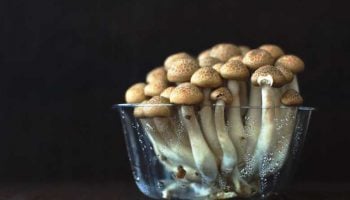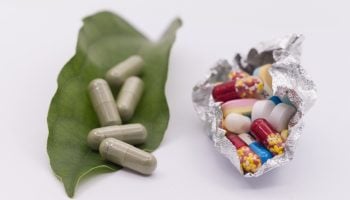The Ultimate Guide to
Microdosing
Ibogaine
Ibogaine is a potentially illegal substance, and we do not encourage or condone the use of this substance where it is against the law. This guide is designed to ensure the safety of those who decide to use the substance legally.
Overview
01Iboga is a shrub from the Apocynaceae family, such as Tabernanthe iboga, Voacanga africana, and Tabernaemontana undulata, which contains the naturally occurring psychoactive indole alkaloid ibogaine. In the iboga plant, the highest concentration of ibogaine is found in the root bark. Lower concentrations of ibogaine are found in the rest of the plant along with other indole alkaloids in the same family.
In the Central African spiritual tradition of Bwiti, iboga root bark is used in rituals and medicinal healing. In the Western world, ibogaine has developed a reputation for having anti-addictive properties, and in several clinical studies has demonstrated the potential to actually reduce addiction.
To find legal iboga retreat centers for addiction or personal growth, check out Third Wave’s vetted directory of providers worldwide.
For the Bwiti, microdosing iboga also acts as a sort of a spiritual housekeeping. Aside from the strong doses taken for spiritual initiation ceremonies, weekly religious ceremonies with lower doses of iboga are also common. These smaller and more frequent rituals bring people together for emotional experiences that strengthen their connection to the divine.
Master the Skill of Microdosing
Enter your info to start your journey on Third Wave's Microdosing Course! Discover a science-based framework for transformational microdosing.
"The course gave me hope, a new way from what I've read and researched before. It has content which any reader can relate to whether you're an addict, an alcoholic or someone suffering from depression or other mental or spiritual ailments. I now feel empowered to take responsibility for my life!"
-Melissa P.
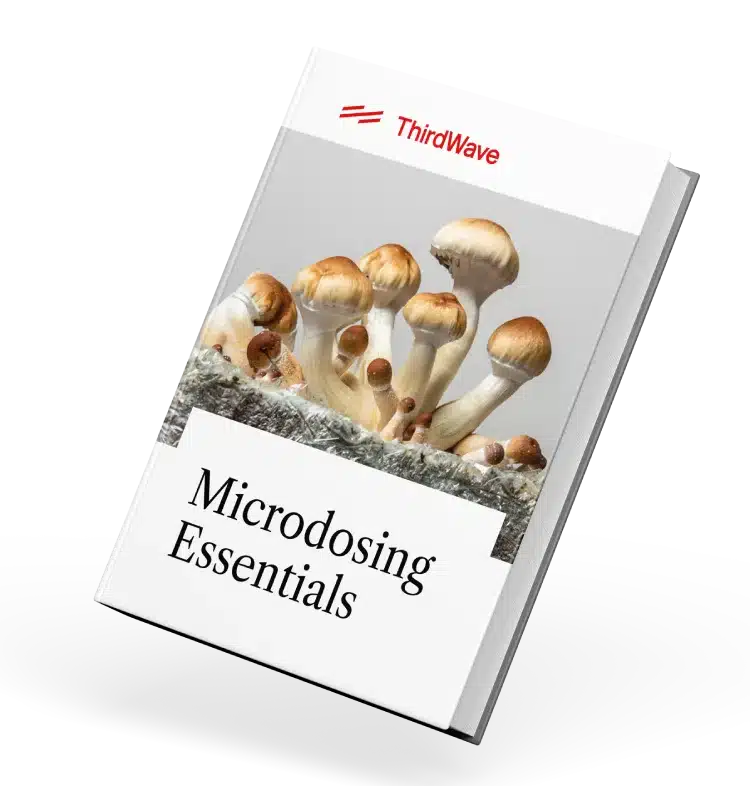

Master the Skill of Microdosing
Enter your info to start your journey on Third Wave's Microdosing Course! Discover a science-based framework for transformational microdosing.
"The course gave me hope, a new way from what I've read and researched before. It has content which any reader can relate to whether you're an addict, an alcoholic or someone suffering from depression or other mental or spiritual ailments. I now feel empowered to take responsibility for my life!"
-Melissa P.
Experience
02How to microdose with iboga
It isn’t easy to establish a set dose for microdosing iboga due to the fact that the substance is unregulated and differs in source and form. The concentration of ibogaine in root bark also varies, so it’s difficult to know exactly how much you’re getting. On top of that, people’s individual reactions to iboga can vary wildly—what may feel like nothing to one person could prove dangerous to another. Iboga provider and expert Chor Boogie even suggests completing an EKG/ECG, liver panel, and psychiatric have having it evaluated by a medical professional familiar with iboga before considering even a small dose of iboga. And iboga expert Elizabeth Bast says that both traditional and medical model providers do not recommend microdosing to anyone that isn’t highly experienced with the medicine.
With all that said and done, 1g is a safe starting point. There are a few options for administering a microdose. For one, the root bark can be chewed and ingested. But this method is not exact, prompting some people to make their own tinctures. A premade iboga TA (total alkaloid) tincture can also be found online. Concentrated at a 1:50 ratio, it is one of the most common ways people microdose with ibogaine, since one drop is an effective amount.
Depending on how ibogaine is extracted from the root bark, it comes in either a powdered TA form or a powdered HCl (hydrochloride). If using the concentrated TA powder, you can start your dose anywhere from 50-100mg. Then, depending on how it affects you, you can tinker with the dose from there. Ibogaine powder in HCl form is purer than the TA form, so try starting at around 25mg per microdose. The powder can be put into capsules, ingested orally, or diluted in liquids. By all accounts, the taste of ibogaine is very bitter and earthy.
A proper amount for a microdose varies from person to person, and depends on your product. Always start with a low amount that you feel comfortable with and work from there.
What schedule should I follow?
As with dosage, timing should be a matter of preference and one’s individual response. Experts in this area suggest different microdosing regimens, but our microdosing course follows James Fadiman’s system. Fadiman recommends taking a microdose once every three days: Take a microdose on Day 1. Then, do not take a microdose on Day 2 or Day 3. On Day 4, take another microdose.

Continue this process for several weeks.
For most people, morning is the best time because the beneficial effects will last throughout the day without interfering with sleep. It’s also helpful to take daily notes in a journal to observe the effects throughout this process and adjust accordingly—or just notice the positive changes.
It’s also important to follow your usual routine while microdosing. The purpose is to enhance your day-to-day existence by integrating microdoses into your routine, so don’t change what you normally do. However, when you try microdosing for the first time, take a day off from work and social commitments. This will give you a chance to notice any unusual effects before microdosing in a more public situation.
While it may seem like you would only feel the effects of the microdose on the days you actually take it, try to observe the effect on the two days between doses, too. Many people perceive increased feelings of flow, creativity, and energy the day after they microdose in addition to the day of microdosing.
If you find the effects becoming stronger each time at the same dose, this may be a sign that ibogaine is accumulating in the liver as noribogaine and you need to slow down or take a break.[1]
Effects
03Pharmacology
Iboga interacts with several neurotransmitter systems simultaneously with its highest affinity being for the sigma-2 receptor. It has a moderate affinity for opioid receptors and a moderate-to-low affinity for serotonin receptors. [2]
Iboga is metabolized by the body into noribogaine, which acts to increase the availability of serotonin in the brain.
Interactions with other drugs
Iboga is metabolized in part by the awkwardly named enzyme cytochrome P4502D6, which is involved in the metabolism of a whole host of other medications and chemicals in the body. That means the list of ibogaine’s dangerous interactions is long.
The risk of experiencing cardiac complications or other dangerous side effects increases when ibogaine is taken in conjunction with antiarrhythmic drugs, anti-depressants, anti-psychotics, and more.[3] Cardiac complications can also be triggered by foods containing bergamottin or bergamot oil, such as grapefruit juice, as well as a variety of other supplements and over-the-counter medications, including Prilosec (Omeprazole), some gastric disorder drugs, anti-fungal medications, HIV treatment drugs, and some antihistamines. This is by no means a complete list of dangerous interactions with ibogaine, and use of the drug should only be considered after proper medical screening and with proper medical support.
The science of microdosing
While there has been some recent research on microdosing, we know a lot more about what large doses of psychedelics do to the brain.
Much of what we understand about how psychedelics work involves serotonin, a chemical that is among the brain’s most important neurotransmitters. Serotonin affects nearly everything we do, from how we feel to how we process information. It keeps our brains ticking.
Much like other classical psychedelics (including LSD), psilocybin, psilocin, and 4-AcO-DMT actually share a similar molecular structure to serotonin. So while SSRI (selective serotonin reuptake inhibitor) antidepressants work to alleviate low mood by increasing serotonin levels in the brain, 4-AcO-DMT would be expected to work more directly by actually mimicking serotonin itself, and stimulating serotonin receptors.
The stimulation of the 5-HT2A receptor in particular has two very important results:
- The production of “Brain Derived Neurotrophic Factor” (BDNF). BDNF is “like Miracle-Gro for your brain. It stimulates growth, connections, and activity.” [4]
- The increased transmission of “Glutamate.” Glutamate is the neurotransmitter most responsible for brain functions like cognition, learning, and memory. [5]
Glutamate and BDNF work together in ways we’re still investigating, but it has become clear that having more of each leads to many of the benefits we seek from microdosing. [6]
Another thing the classical psychedelics are capable of doing is causing parts of the brain that wouldn’t usually communicate with one another to communicate with one another. Psychedelics facilitate these unique connections by dampening the activity of an often-overused part of our brain called the “Default Mode Network” (DMN). [7]
The DMN features in a range of mental activities, including daydreaming, self-reflection, and thinking about the past or future. And some studies suggest depression may be linked to an overactive DMN, [8] possibly causing us to ruminate, over-analyze or criticize ourselves, and continually step out of the present moment to fret about the past or the future.
This helps to explain the remarkable efficacy of psilocin and related substances in the treatment of depression and anxiety, [9][10] with some patients even reporting lasting (six months+) relief from a single high dose of psilocybin. [11] It could also help to explain how the use of these substances can lead to creative insights and perspectives that otherwise remain inaccessible.

Everything you need to know about Microdosing in one place
Download our FREE guide to learn how to begin a microdosing regimen, calibrate your dose level, and get the most out of your experience.
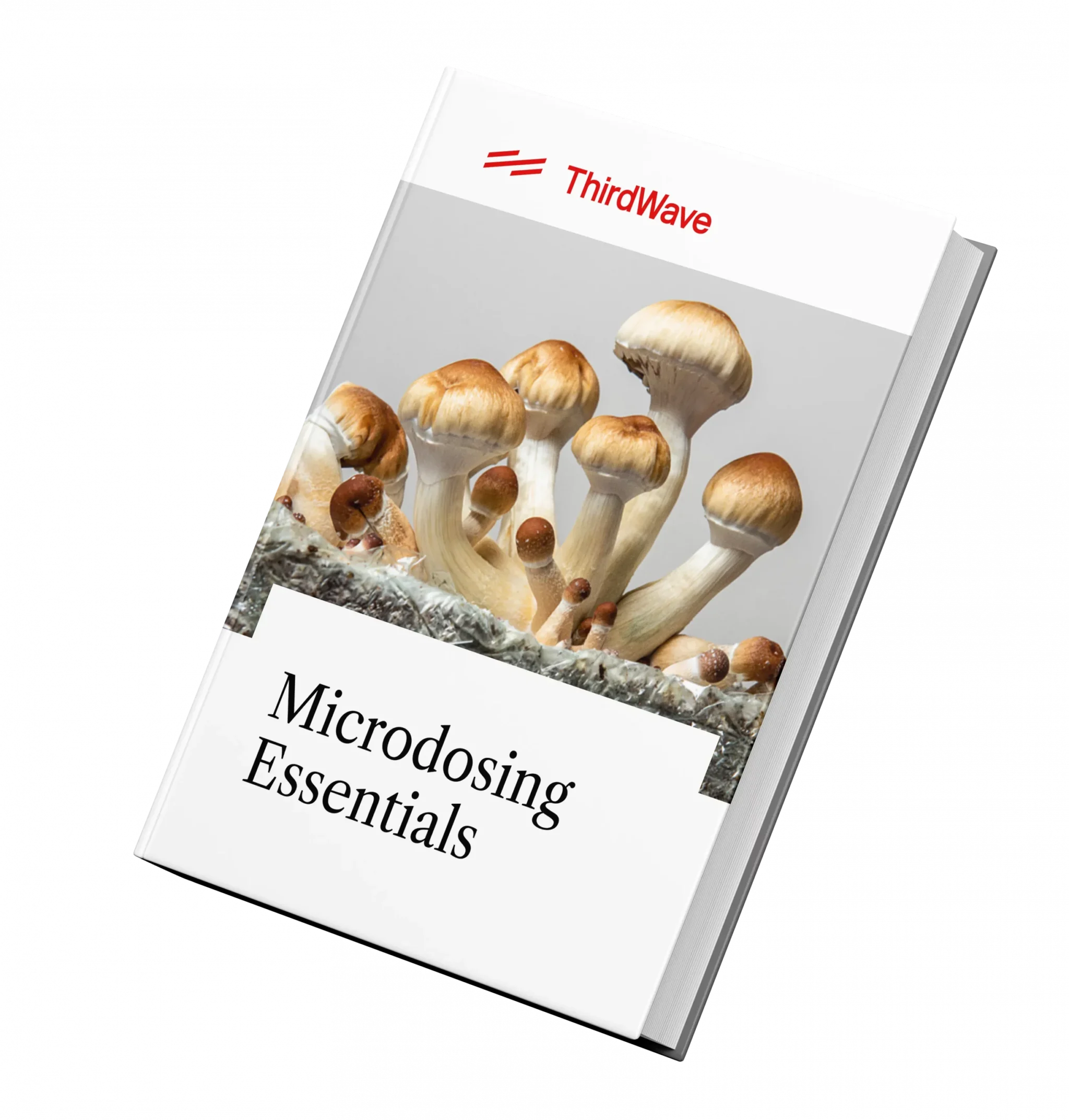
“This FREE Guide was just what I needed to take the first step into Microdosing. AND IT WAS THE BEST DECISION OF MY LIFE! After starting my microdosing regiment I now have more focus, energy and clarity into what it is I truly want in this world.”
James, New York

Everything you need to know about Microdosing in one place
Download our FREE guide to learn how to begin a microdosing regimen, calibrate your dose level, and get the most out of your experience.
Benefits & Risks
04Potential Benefits
Iboga is a powerful substance for treating addiction, addressing trauma and otherwise gaining clarity for contemplation and reflection. And microdosing is a safe way to experience these benefits without committing to a full dose.
Anecdotal reports on the effects of microdosing iboga show that the practice could help with addictions and cravings of all kinds. Microdosing in the wake of a full ‘flood’ dose can be especially useful for helping maintain benefits like clarity, enhanced mood, and craving control, all of which otherwise tend to wear off as one eases back into everyday life.[12]
We all have addictive patterns and behaviors that we may not even notice, yet unconsciously act on every day. Commonly, people who microdose iboga switch to a more detached perspective. This change allows them to recognize patterns of behavior without giving in to them, which helps explain iboga’s effectiveness for addiction and withdrawal symptoms. One user reported that microdosing with iboga helped him stop a 30-year tobacco addiction, with no withdrawal.[13] He added that the iboga helped with other, subtle addictions like “junk food, emotional outbursts, and reacting or being affected by a negative thought process.”
On top of addressing addictions, people also microdose iboga for self-discovery and to treat trauma or depression – thanks in part to the way it promotes self-acceptance and control over negative thinking. Entrepreneur and best-selling author Tim Ferriss, for example, chooses to microdose ibogaine to treat depression and enhance cognition instead of psilocybin mushrooms due the issues of accurately dosing psilocybin mushrooms. One woman who developed DID (Dissociative Identity Disorder) following a traumatic event, for instance, began to microdose with iboga and found her symptoms improved after about a week. She noted that “I received insight into some traumatic issues. Specifically, I had visions of a few traumatic childhood situations I had not previously remembered. I experienced these from an observer-perspective, i.e. I saw what happened but did not re-experience the situation from a first-person perspective. Even more remarkably, I could then step into the situation and change it.”[14] The new insights and perspective allowed her to address the situation. “I feel like my brain has been re-wound to about the state of a few years ago (before I went through some traumatic times that finally resulted in my DID crisis).”
A stimulant effect has also been associated with microdosing, giving users an energy boost, along with sharpened focus and enhanced creativity and productivity.[12]
Patrick Kroupa, ex-addict and iboga expert, also hails the recreational aspects of ibogaine microdosing, saying: “I’ve microdosed ibogaine because I want to enjoy my work more that day, or I want to have a good workout, or quite honestly because sex is great on small doses of ibogaine.” [15]
Risks
Iboga is one of the most powerful and medically volatile medicines, according to author and plant medicine facilitator Elizabeth Bast. While that makes its therapeutic potential high, iboga use isn’t without risk and must be treated with care and attention. Reports of toxicity-related complications caused by ibogaine have largely been due to previous medical conditions (mostly cardiac), as well as drug-drug interactions. It is very important to avoid using ibogaine if you have a pre-existing heart condition. The combination can be lethal.[16]
A review that looked at medical records from 1990 to 2008 found that 19 people died anywhere from about an hour to three days after using iboga. However, none of these deaths could be attributed to toxic effects of the drug itself, but rather to interactions either with prior medical conditions or other drugs.[17]
However, there are also reports of people suffering a fatal reaction to iboga even after a medical screening. It’s estimated that up to 1 in 400 people who take iboga suffer a fatal reaction, which makes it a higher risk endeavor than most extreme sports.
For drug addiction treatment, iboga should only be taken under the direct supervision of a trained medical professional. The Global Ibogaine Therapy Alliance recently established criteria that require a physician’s assessment before a patient can undergo ibogaine treatment.
Therapeutic Use
05Two recent studies also showed that a single iboga treatment can successfully reduce withdrawal symptoms in opiate addicts, and help keep their cravings at bay for months afterwards.
The largest observational study of iboga’s potential benefits in the treatment of addiction suggests the treatment could significantly improve opioid abstinence in sufferers of chronic addiction. Of 88 subjects interviewed, 80% reported that iboga either drastically reduced or totally abated their withdrawal symptoms, with 30% abstaining from opioid use for years following the treatment.[20]
Iboga treatments have also been shown to have lasting effects after a single session—but in some cases, additional treatment is required. This is where microdosing could come in handy—smaller, more frequent doses of iboga are thought to reinvigorate the effects of a full-dose experience. [21]
Iboga also shows promise in the treatment of neurodegenerative disorders like Parkinson’s disease, helping sufferers to stand, walk, and feed themselves.[1] Specifically, it seems to stimulate the release of the growth factors GDNF (glial cell line-derived neurotrophic factor) and BDNF (brain-derived neurotrophic factor), resulting in the formation of new neural connections and replacement of damaged ones.[12] Of course, this has further implications for benefits like creativity, learning, and mental health.
Personal Growth
06Like many other psychedelics, iboga has the ability to temporarily shatter the ego, giving you more perspective on the interconnectedness of the world around you and taking power from the petty problems of daily life. During these brief periods of egolessness, people often receive powerful insights into the personal issues they’re facing—and the insights needed to move forward.
In the acute and reflective phases of an iboga session, people also often experience intellectual insights into their emotional problems. Deeply repressed pain and trauma rise to the surface. While this can be difficult and emotionally turbulent, it often allows people to confront their demons. It’s helped people deal with depression, anxiety, PTSD, addiction to shopping, sex, food, and much more.
While iboga can be an intense and unsettling experience, most people also report that they feel a simultaneous sense of peace and calm, and a greater connection to the universe that can last long after the session has ended. And while these experiences largely come from full-dose experiences, microdosing iboga could also produce these benefits.
Are you feeling drawn to work with iboga? Third Wave’s vetted Psychedelic Directory offers an in-depth list of trusted iboga retreat centers worldwide.
Get Your FREE Ultimate Guide To Microdosing for Depression.
Sometimes hope comes in micro-doses. This guide will walk you through the process and how to best use the healing potential of psychedelics in a safe, intentional way to heal depression.
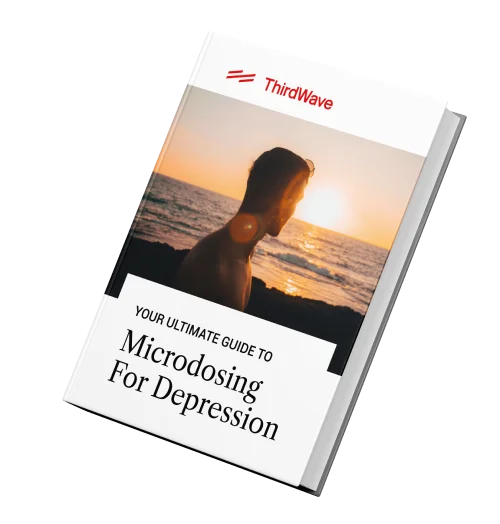

Get Your FREE Ultimate Guide To Microdosing for Depression.
Sometimes hope comes in micro-doses. This guide will walk you through the process and how to best use the healing potential of psychedelics in a safe, intentional way to heal depression.
Macrodosing
07Still, a full dose of iboga can lead to deep personal insights gained in the egoless state that iboga can bring about—people often receive powerful insights into the personal issues they’re facing and feel a greater connection to the world around them. In this context, iboga can help spark personal growth in myriad forms—it’s helped people deal with depression, anxiety, PTSD, indulgent behaviors, and much more.
However, due to iboga’s volatile nature, it’s recommended that you not experiment with it on your own and instead seek a professional and experienced facilitator. As of now, there are some 75 to 100 iboga treatment facilities around the world. In recent years, new treatment centers outside of the United States have been popping up quickly to meet the growing demand for iboga treatment.
For information on macrodosing iboga—and what to look for in a treatment facility—check out our Ultimate Guide to Ibogaine.
Legality
08Although illegal in the United States, iboga can be consumed with relative freedom in the City of Oakland, CA. On June 4, 2019, the city council voted unanimously to decriminalize all “entheogenic plants” containing indoleamines, tryptamines, and phenethylamines. This allows adults aged 21 years and older to use them either medicinally (in accordance with the resolution’s official intent) or for any other reason without fear of criminal punishment. It also specifically decriminalizes (or rather deprioritizes for law enforcement) their cultivation and distribution.[23][24]
Iboga is also legal to possess and distribute in Brazil, Mexico, South Africa, Gabon, New Zealand, the Netherlands, and Costa Rica. Treatment centers exist in most of these countries.
For a full guide to the legality of ibogaine worldwide, click here.
History
09Brief history
The first reports of iboga use in the West came from French and Belgian explorers who observed African spiritual ceremonies in the second half of the 19th century. The chemical compound was first isolated in 1901 by two independent research groups, but a complete synthesis was not accomplished until 1966.
From the 1930s to 1960s, ibogaine was sold as a stimulant in France under the brand name Lambarène, which was an extract of the Tabernanthe manii plant. However, in 1966, it was taken off the market when France prohibited the sale of all ibogaine-containing products.
Around the same time, the World Health Assembly classified ibogaine as a “substance likely to cause dependency or endanger human health,” and the Food and Drug Administration (FDA) designated ibogaine Schedule I.
Iboga’s anti-addictive effects were discovered accidentally in the 1960s by a 19-year-old heroin addict named Howard Lotsof. He and five of his addict friends all noticed a reduction of their heroin craving and withdrawal symptoms after taking iboga for recreational purposes.
In the early 1990s, the National Institute on Drug Abuse (NIDA) funded and conducted animal trials with ibogaine in the US, although the doses used were considerably higher than effective human doses.[25] Despite safety concerns highlighted by these trials, phase I clinical trials were carried out using ibogaine to treat opioid addicts. Between 1992 and 1993, a cohort of 33 heroin addicts were treated with 6 to 29 mg/kg of ibogaine. Of this group, 25 showed resolution of opioid withdrawal symptoms 24 to 72 hours after their treatment. However, a 24-year-old female who received the highest dosage died.[26] This death raised safety concerns around ibogaine treatment.
While ibogaine is illegal in the United States today, it is available as a prescribed anti-addiction treatment in many countries, including Canada, South Africa, the Netherlands, Mexico, Norway, and the U.K. among others.[27]
The history of microdosing
While the modern history of psychedelics reaches back to the 1950s, interest in microdosing saw a major revitalization with the publishing of psychologist and psychedelic advocate Dr. James Fadiman’s book, The Psychedelic Explorer’s Guide: Safe, Therapeutic, and Sacred Journeys in 2011, which explores microdosing as a subculture of psychedelic use. While a number of indigenous cultures—as well as modern professionals—have used microdosing to unlock a host of personal benefits, Fadiman’s book formally introduced the term “microdosing” into the mainstream.
Beyond coining the term, The Psychedelic Explorer’s Guide awakened the curiosity and imaginations of millions of people and provided practical information for anyone interested in giving microdosing a try. Much of this information has been integrated into this guide.
Outside of the book, Fadiman’s ongoing research also serves as one of the few modern studies into the effects of microdosing specifically—most current psychedelic research looks at the effects of larger doses on specific therapeutic outcomes.
Following the publication of The Psychedelic Explorer’s Guide, the next boost in the public’s awareness of microdosing came from a podcast interview Fadiman gave with investor and author Tim Ferriss in March 2015. Ferriss, who rose to fame after authoring the bestseller, The 4-Hour Work Week, has an enormous audience of individuals interested in entrepreneurship, “biohacking,” self-experimentation, psychology, spirituality, and other subjects that predispose them to an interest in the benefits of microdosing. The interview boosted Fadiman’s core microdosing messages and created more mainstream interest in the practice: soon after its air date, Ferris fans began experimenting with microdosing and discussing it in their own personal networks. Journalists also jumped on board and began writing articles about microdosing, creating even greater awareness and interest.
Interest in microdosing got another boost when author Ayelet Waldman’s published her 2016 book, A Really Good Day: How Microdosing Made a Mega Difference in My Mood, My Marriage, and My Life, which tracked her 30-day LSD microdosing protocol.
Before Ayelet started microdosing, she spent years struggling to understand her condition and find relief from erratic mood swings. Doctors originally diagnosed Ayelet with bipolar disorder and later with premenstrual dysphoric disorder, which closely aligned with her symptoms. But she continued struggling with day-to-day life. Ayelet said her mood swings became severe enough to put her marriage and relationship with her children at risk. However, after the 30-day protocol, everything changed. “This month changed my life,” she said in an interview with Third Wave, “and I am sad every day that I can’t keep doing it legally.”
Mycologist and psilocybin-enthusiast Paul Stamets has also had a hand in pushing microdosing into the mainstream. One of the most reputable, decorated, and self-practiced mycologists in the world, Stamets has dedicated his life to the study of medicinal and psychedelic fungi. His most recent patent application is for a nootropic stack (a combination of cognitive enhancers) that contains a microdose of psilocybin, lions mane, and niacin. He would like to see this supplement available as a vitamin, claiming that its efficacy in epigenetic neurogenesis has the potential to initiate “the next quantum leap in human consciousness.”
Now, tens of thousands of people around the globe are experimenting with taking small doses of psychedelics in the name of mental health, creativity, and inspiration.
Get Your FREE Ultimate Guide To Microdosing for Depression.
Sometimes hope comes in micro-doses. This guide will walk you through the process and how to best use the healing potential of psychedelics in a safe, intentional way to heal depression.


Get Your FREE Ultimate Guide To Microdosing for Depression.
Sometimes hope comes in micro-doses. This guide will walk you through the process and how to best use the healing potential of psychedelics in a safe, intentional way to heal depression.
Ethical Considerations
10Sustainability and Cultural Appropriation of the Iboga Plant
Due to a confluence of factors, the iboga plant population is facing pressure in its native habitat in Gabon. One problem is the destruction of habitat due to widespread deforestation to claim farmland. Deforestation is also endangering elephants, which are crucial in spreading the iboga seed.
The creation of a profitable ibogaine market in response to the opioid epidemic has led to a spike in the number of harvesters and distributors of the iboga plant which, in turn, has led to a shortage in some areas and subsequent rapid price increases. Meanwhile, many of the shamans and other practitioners native to Gabon who carry on the ancient traditions of the Iboga plant remain impoverished.
Furthermore, the explosion in Ibogaine use outside Gabon typically occurs with little to no acknowledgment of the ancient sacred cultural practices of the Iboga plant, giving rise to concerns over the cultural appropriation of yet another indigenous practice.
It’s up to us outsiders to ensure that it’s done in a more respectful manner than it has been in many cases to date.
To learn more, see our Ultimate Guide to Ibogaine.
FAQ
11Can Ibogaine be detected in a drug test?
No drug tests screen for ibogaine in blood or urine.[28] Ibogaine is also very unlikely to trigger a false negative, especially in microdoses, since it’s chemically dissimilar to drugs that are commonly screened for.
Where can I get Iboga?
Iboga comes in a variety of forms, including in the root bark itself. This can be chewed on directly or used to extract the chemical. Otherwise, ibogaine alone available in powder (TA or HCl), tincture, and capsule preparations.
For microdosing, the root bark may be preferable due to its lower concentration (typically 3-6%) of ibogaine, in turn making it easier to avoid overdosing. On the other hand, extracts are standardized and more precise, and the HCl powder in particular is commonly associated to Parkinson’s improvements.[12]
Either way, be warned that there are scammers who sell fake or poorly sourced iboga and ibogaine, or who run fake ibogaine retreats. Regardless of whether you’re buying ibogaine for microdosing or attending a retreat, it’s crucial to research any source before spending money or trying the substance. Most reports say their experience was simply ineffective or overpriced, but it is possible that a seller might give you some other dangerous substance instead of ibogaine. Be very careful to make sure your source is reputable.
For a complete list of trusted iboga retreat centers worldwide, visit Third Wave’s Psychedelic Directory.
Is microdosing Ibogaine illegal?
Both iboga and extracted ibogaine are listed as Schedule I controlled substances in the US (although iboga has been decriminalized in Oakland, CA). However, ibogaine is unregulated in many other countries, including Canada, Mexico, Germany, and Brazil. In some cases, however, use is restricted to authorized treatment centers only.
Is microdosing Ibogaine safe?
Although the risks of microdosing ibogaine have yet to be meaningfully researched, full ‘flood’ doses have been known to cause death by altering heart function, and in particular by lengthening the QT interval in the heart’s electrical cycle.[12] In fact, based on statistics between 1989 and 2006, roughly 1 in 400 people are estimated to suffer a fatal reaction to ibogaine.[29] It should therefore be avoided by anyone with an existing heart condition.
As mentioned above, it’s also important not to combine it with other drugs, including many antidepressants. Opiates, psychedelics, and amphetamines should be avoided too, due to ibogaine’s amplification of opioid signaling in the brain and interaction with the serotonergic system.[12]
One thing is for certain – with microdosing, there is no risk of having a “bad trip” or experiencing intense psychedelic effects. Taking a microdose is often the ideal way to be introduced to psychedelics safely and comfortably.
How do I get started with microdosing?
There are lots of things to cover before you get started with microdosing – depending on the reasons you’re interested in the first place!
For general information on microdosing, sign up to our extensive microdosing course to gain access to curated materials that will help you design the ideal microdosing regimen for your needs. You’ll also gain access to an exclusive community of enthusiastic, helpful microdosers.
Iboga-specific forums, including the ibogaine subreddit, are also good resources to get started.
Footnotes
12[1] Ibogaine Microdosing. Ibogaine. Retrieved from https://www.ibogainemicrodosing.org/ibogaine.
[2] Lotsof, H. S., & Alexander, N. E. (2001). Case studies of ibogaine treatment: implications for patient management strategies. Alkaloids. New York Academic Press, 56, 293–313.
[3] Brown, T. K. (2013). Ibogaine in the treatment of substance dependence. Current Drug Abuse Reviews, 6(1), 3–16.
[4] Waldman, A. (2017). A Really Good Day: How Microdosing Made a Mega Difference in My Mood, My Marriage, and My Life. New York: Anchor Books.
[5] Riedel, G., Platt, B., Micheau, J.(2003). Glutamate receptor function in learning and memory. Behavioural Brain Research, 140(1-2):1-47. doi:10.1016/S0166-4328(02)00272-3
[6] Vollenweider, F. X., Kometer, M. (2010). The neurobiology of psychedelic drugs: implications for the treatment of mood disorders. Nature Reviews Neuroscience, 11:642-651. doi:10.1038/nrn2884
[7] Carhart-Harris, R. L., et al. (2016). Neural correlates of the LSD experience revealed by multimodal neuroimaging. National Academy of Sciences, 113(17):4853-4858. doi:10.1073/pnas.1518377113
[8] Sambataro, F., Wolf, N. D., Pennuto, M., Vasic, N. (2014). Revisiting default mode network function in major depression: evidence for disrupted subsystem connectivity. Psychological Medicine, 44(10):2041-2051. doi:10.1017/S0033291713002596
[9] Jesse Singal. (2016, Dec 2). Psilocybin, the Active Ingredient in ’Shrooms, Is Looking More and More Like a Potential Wonder Drug. Retrieved from https://www.thecut.com/2016/12/psilocybin-research-looks-very-exciting.html.
[10] Carhart-Harris, R.L., et al. (2016). Psilocybin with psychological support for treatment-resistant depression: an open-label feasibility study. The Lancet, 3(7):619-627. doi:10.1016/S2215-0366(16)30065-7.
[11] Griffiths, R.R., et al. (2016). Psilocybin produces substantial and sustained decreases in depression and anxiety in patients with life-threatening cancer: A randomized double-blind trial. Journal of Psychopharmacology, 30(12):1181-1197. doi:10.1177/0269881116675513.
[12] Ibogaine Microdosing. Benefits. Retrieved from https://www.ibogainemicrodosing.org/benefits.
[13] Iboga World. Iboga root can give absolutely astonishing results if taken properly. Retrieved from http://www.ibogaworld.com/iboga-root-can-give-absolutely-astonishing-results-if-taken-properly/.
[14] tribeofone. (2013, May 4). Low dose Ibogaine – astonishing results! [Online forum comment]. Message posted to https://www.psychforums.com/dissociative-identity/topic112969.html#p1130231.
[15] The Ibogaine Conversation Part 6. Retrieved from https://www.psymposia.com/magazine/patrick-kroupa-hacker-ex-heroin-junkie-microdosing-medicalization-ibogaine/
[16] Davis et al (2017). Subjective effectiveness of ibogaine treatment for problematic opioid consumption: Short- and long-term outcomes and current psychological functioning. J Psychedelic Studies 1(2), 65-73.
[17] MAPS – Ibogaine Therapy for Drug Addiction.
[18] ICEER. More about Iboga. Retrieved from http://www.iceers.org/more-about-iboga.php?lang=en#.WhwkKNJl_ox.
[19] Ibogaine Microdosing. FAQ. Retrieved from https://www.ibogainemicrodosing.org/faq.
[20] Mash, D. C., Kovera, C. A., Pablo, J., Tyndale, R. F., Ervin, F. D., Williams, I. C., … Mayor, M. (2000). Ibogaine: complex pharmacokinetics, concerns for safety, and preliminary efficacy measures. Annals of the New York Academy of Sciences, 914(1), 394–401.
[21] Ibogaine in the 21st Century: Boosters, Tune-ups and Maintenance. Retrieved from http://www.maps.org/news-letters/v15n1/iboga21.pdf
[22] Haglage, A. (2014, Apr 5). Hallucinating Away a Heroin Addiction. Retrieved from http://www.thedailybeast.com/articles/2014/05/04/saving-grace-a-junkie-s-trip-to-freedom-through-ibogaine.html.
[23] AP. (2019, Jun 5). The Latest: Oakland 2nd US city to legalize magic mushrooms. Retrieved from https://www.apnews.com/ff023dfbf4534eba8622f504d272ff00.
[24] Decriminalize Nature Oakland. Resolution. Retrieved from https://www.decriminalizenature.org/dno-resolution.
[25] Alper, K. R., Lotsof, H. S., Frenken, G., Luciano, D. J., & Bastiaans, J. (1999). Treatment of acute opioid withdrawal with ibogaine. The American Journal on Addictions, 8(3), 234–242.
[26] Mach, R. H., Smith, C. R., & Childers, S. R. (1995). Ibogaine possesses a selective affinity for σ2 receptors. Life Sciences, 57(4), PL57–PL62.
[27] Litjens, R. P. W., & Brunt, T. M. (2016). How toxic is ibogaine? Clinical Toxicology (Philadelphia, Pa.), 54(4), 297–302.
[28] Erowid. (2015, Feb 10). Ibogaine — Drug Testing. Retrieved from https://erowid.org/chemicals/ibogaine/ibogaine_testing.shtml.
[29] Global Ibogaine Therapy Alliance. Is Ibogaine Therapy Safe? Retrieved from https://www.ibogainealliance.org/ibogaine/therapy/safety/.
Everything you need to know about Microdosing in one place
Download our FREE guide to learn how to begin a microdosing regimen, calibrate your dose level, and get the most out of your experience.

“This FREE Guide was just what I needed to take the first step into Microdosing. AND IT WAS THE BEST DECISION OF MY LIFE! After starting my microdosing regiment I now have more focus, energy and clarity into what it is I truly want in this world.”
James, New York

Everything you need to know about Microdosing in one place
Download our FREE guide to learn how to begin a microdosing regimen, calibrate your dose level, and get the most out of your experience.
